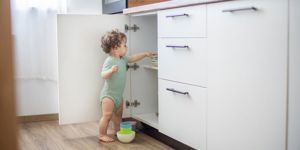My youngest just turned a year old and is in full-fledged walking (read: running) mode! As I pulled out our bottom-of-the-stairs baby gate and dusted it off, I was filled with a mix of emotions. On one hand, how exciting is it to see our baby finally off and moving and exploring everything around him! On the other hand, how annoying that I have to be even more vigilant about what is within his reach.
Some of my babies have certainly 'needed' more baby proofing than others, depending on our home and the personal curiosities my babies had. Thankfully, this guy seems to be giving us an easy time of it all as he seems genuinely content with his actual baby toys (who am I kidding, the TV remote reigns supreme as the ultimate baby and toddler attraction).
However, regardless there are a few things I know I need to be sure to have squared away to have his best interest at heart. Even the most vigilant of parents need to be prepared in the inevitable event that they take their eyes off their baby or toddler for even a second. They are faster than you think!
Note: Baby-proofing can be a misleading term as babies and toddlers can be curious, fast, and determined. Sometimes we may believe something is securely 'proofed' only to find our child has out-smarted or out-maneuvered the devices we used to try and hinder them. No baby-proofing can replace a vigilant caregiver. You are your child's first line of protection. Keeping an eye on them and lovingly deterring them from potential harm should be the plan with baby-proofing as the secondary backup plan - not the other way around! While responsive safety is important (things like first aid, Heimlich maneuver, etc.) we are looking for preventative safety in baby-proofing; eliminating as much danger as possible beforehand.
Simply click here and enter your details for your chance to win a $250 Amazon spend today!
Baby Proofing Tasks
This is a comprehensive checklist that can be applied as needed to each room of your home. Scroll to the bottom of this post for a printable checklist that goes room-by-room.
- Install Baby Gates: it doesn't take long after your baby is mobile to realize exactly how big your home is. While chasing after your little one is always an option, it is less than ideal. Save time and energy by blocking off areas such as stairs or rooms you don't want your baby going into by utilizing gates. (Again, like all baby-proofing, baby gates are not a replacement for watchful care. While they can be a helpful tool, never fully rely on baby gates alone to keep your child safe).
- Move arms-reach items: move things such as electronics, house plants, or breakable items like picture frames out of reach. Sometimes we are unable to 'see' potential hazards that we are used to having in certain places until your baby is already reaching for it, so take some time to give your surroundings a look with fresh eyes focused on finding potential issues. Pay special attention to places like the laundry room or the bathroom where you may have cleaners or chemicals within arms reach. It may be less convenient to put them away, but you can get them back out once your child is old enough to no longer be at risk for touching or ingesting them.
- Watch for choking hazards: do you have an older child who loves LEGO bricks? Or a cat with a toy mouse equipped with a bell? Items that previously were perfectly fine to have in your living space can now pose choking hazards for your new explorer. Babies instinctively put things in their mouths, and even larger items can sometimes have smaller parts that are capable of coming off and harming your baby. Make a habit of keeping these items out of your baby's reach or out of rooms they will be in completely.
- Outlet covers: One of the easiest baby-proofing tasks is adding covers to your home's outlets. While it may be annoying to take them out when you need to vacuum or plug something in, the peace of mind of knowing your baby will not be able to inadvertently shocked or electrocuted is worth any minor inconvenience. There are all kinds of easy-install options and even more advanced ones that allow adults to slide open for easier access without sacrificing safety.
- Cabinet locks: Often things in cabinets become out of sight, out of mind. Unfortunately, cabinets are a well-known favorite for babies and toddlers to explore and plunder. The bottle of house cleaner you keep under your sink can quickly become a hazard in the hands of a small child. Being sure to install strong locks on cabinets in places like the kitchen and bathroom can be an important step in maintaining your home's safety. Note: Gun cabinets should always be equipped with a child-proof lock, preferably a combination that is unknown and cannot be easily guessed by anyone who should not have access)(.
- Drawer locks: once your toddler can open drawers, you'll want to be sure that there are no sharp knives or other dangerous objects within reach. Consider drawer locks like your cabinets, or rearrange drawers completely so that hazards are out of reach.
- Electrical cords: Ensure that appliances and devices are never left plugged in or with cords dangling. Not only can your baby or toddler unplug the item for access to the outlet but it is too easy for them to pull things like mixers, blenders, laptops, or gaming systems onto themselves when these things are left unattended. Instead, keep unused appliances and devices unplugged with their cords safely wrapped out of reach. If an item must be plugged in, keep the cord out of your baby's reach and consider usable outlet covers that allow things to remain plugged in without being able to be unplugged.
- Blinds: Even non-electrical cords can present significant danger to your child as strangulation or circulation risk if they become wrapped around your child's neck, limbs, or fingers. Keep blind cords short and wrapped out of your child's reach and away from furniture they may climb onto such as cribs, sofas, tables, and chairs.
- Cushion sharp corners: Coffee tables, entertainment centers, and fireplaces are just a few of the places your baby may encounter sharp corners and edges. As they are learning to move they will inevitably tumble now and then. While minor bumps and bruises may be an inevitable part of the process, your baby can become seriously injured if they were to fall on a sharp edge or corner. Move/replace dangerous furniture pieces if possible, or invest in some corner cushions to help mitigate the danger.
- Trash cans: When you throw something in the trash, you'd typically like it to stay there. Babies and toddlers have no such desire and will promptly empty any trash cans of their contents before playing with and/or eating said contents. This can be annoying, but also a health and safety risk depending on what was in the trash can. Keep trash cans up and out of reach, behind closed doors or baby gates, or invest in a child-proof trash can.
- Furniture mounts: The dangers of furniture tipping have always existed but there has been significantly more awareness from furniture companies such as IKEA taking more proactive measures. The idea is to minimize the risk of a child climbing on or pulling furniture that could potentially tip over and fall on top of them causing serious injuries or even death. Most new furniture will come equipped with wall-mounting hardware, but you can purchase additional hardware for older pieces, or even more sturdy hardware if you have a particularly heavy piece or would like to be extra cautious.
- Smoke and Carbon Monoxide detectors: Having working smoke and carbon monoxide detectors in your home is a safety precaution that you should already have in place, but if you do not take the time to ensure that you have a sufficient number of detectors placed properly and in working order. You can reach out to your local fire department if you need additional help or advice with this. (Note: Other general safety issues to be aware of and look out for in your home while you are in safety mode would be things like black mold, lead paint, and asbestos. Many people are surprised to find that their homes contain these things without their knowledge so it never hurts to be on the lookout).
- Fireplace: If your home has a fireplace (or multiple!) take care to ensure that it is secured as properly as possible and that fireplace tools like pokers and shovels are nowhere your baby or toddler can access. Additionally, consider keeping wood piles in a room your baby cannot access, or outdoors to avoid pinched fingers or any tipping accidents that could risk your child being crushed. There are many 'child-proof' fire screens on the market, but there is no such thing as a true child-proof fire screen. Even if a child is prevented from physically entering your fireplace they are still at serious risk of being burned by embers or residual heat. Never leave a child alone in a room with a burning fire, no matter their age or how short of a time you will be gone.
- Knob covers: If your stove or oven has knobs on the front you may be surprised at how quickly your little one can reach and manipulate them to inadvertently turn the stove or oven on, presenting a hazard for burns or even fires.
- Toilet lock: Installing a childproof lock on your toilet can save a lot of mess and frustration. The less you can worry about whether or not your child has been exposed to unsanitary conditions such as the inside of your toilet bowl, the better, While you're at it, consider making an effort to move any plungers or toilet brushes out of reach.






